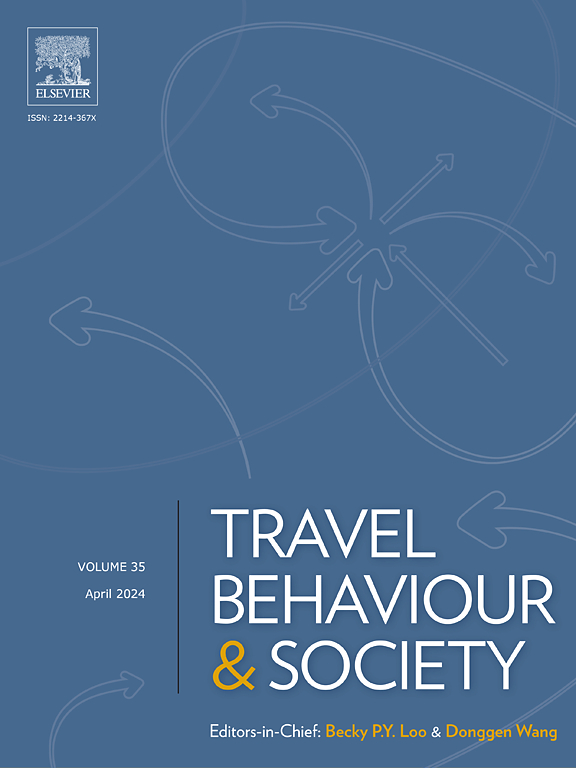Walking in the city of footbridges: Sense of community, subjective walkability and walking habits in a layered neighborhood
IF 5.7
2区 工程技术
Q1 TRANSPORTATION
引用次数: 0
Abstract
This paper explores the sense of community (SoC) in Tsuen Wan, Hong Kong, an urban area where layered pedestrian networks shpae patterns of physical and social connections. It examines how Tsuen Wan’s network of footbridges and sidewalks relates to different walking habits, perceived walkability and SoC. Based on a questionnaire survey conducted among commuters and generalized structural equation modeling (GSEM), the study identifies patterns in how these urban infrastructures correspond with community dynamics. The findings show that frequent leisurely walking on sidewalks is positively linked to subjective walkability but lower reported SoC. However, spending more time on leisurely walks on sidewalks shows a positive association with SoC, suggesting that time spent, rather than frequency, may be more relevant to feelings of community connection. In contrast, both the frequency and duration of utility walking, whether on footbridges or sidewalks, are negatively associated with subjective walkability and SoC. The study also highlights that gender and income significantly are associated with SoC, with males and higher-income individuals reporting stronger SoC and greater walkability satisfaction. This pattern points to the potential importance of social and economic capital, as well as safety perceptions. Additionally, local Hongkongers exhibit a higher SoC despite walking less for leisure, possibly reflecting the role of strong social and network capital in maintaining community bonds even with fewer casual interactions. This research contributes to the SoC and transportation literature by emphasizing both the mobility and social functions of urban streets. It underscores the need for urban planning that supports both transient and sustained social interactions, recognizing the importance of diverse, mobile experiences that underpin a dynamic and inclusive sense of community.
步行在城市的人行桥:社区意识,主观步行能力和步行习惯在一个分层的社区
本文探讨了香港荃湾的社区意识(SoC),这是一个城市地区,分层的行人网络形成了物理和社会联系的模式。该报告探讨了荃湾的行人天桥和人行道网络如何与不同的步行习惯、可感知的步行性和SoC相关联。基于对通勤者的问卷调查和广义结构方程模型(GSEM),该研究确定了这些城市基础设施如何与社区动态相对应的模式。研究结果表明,经常在人行道上悠闲地散步与主观步行能力呈正相关,但报告的SoC较低。然而,花更多的时间在人行道上悠闲地散步与SoC呈正相关,这表明花费的时间,而不是频率,可能与社区联系的感觉更相关。相比之下,无论是在人行天桥还是人行道上,公用事业步行的频率和持续时间都与主观步行性和SoC呈负相关。该研究还强调,性别和收入与SoC显著相关,男性和高收入个体报告更强的SoC和更高的步行满意度。这种模式指出了社会和经济资本以及安全观念的潜在重要性。此外,尽管香港人在休闲时走路较少,但他们的社会责任指数较高,这可能反映了强大的社会和网络资本在维持社区联系方面的作用,即使他们的休闲互动较少。本研究通过强调城市街道的流动性和社会功能,为SoC和交通文献做出了贡献。它强调了支持短暂和持续社会互动的城市规划的必要性,认识到多样化、移动体验的重要性,以支撑充满活力和包容性的社区意识。
本文章由计算机程序翻译,如有差异,请以英文原文为准。
求助全文
约1分钟内获得全文
求助全文
来源期刊

Travel Behaviour and Society
TRANSPORTATION-
CiteScore
9.80
自引率
7.70%
发文量
109
期刊介绍:
Travel Behaviour and Society is an interdisciplinary journal publishing high-quality original papers which report leading edge research in theories, methodologies and applications concerning transportation issues and challenges which involve the social and spatial dimensions. In particular, it provides a discussion forum for major research in travel behaviour, transportation infrastructure, transportation and environmental issues, mobility and social sustainability, transportation geographic information systems (TGIS), transportation and quality of life, transportation data collection and analysis, etc.
 求助内容:
求助内容: 应助结果提醒方式:
应助结果提醒方式:


